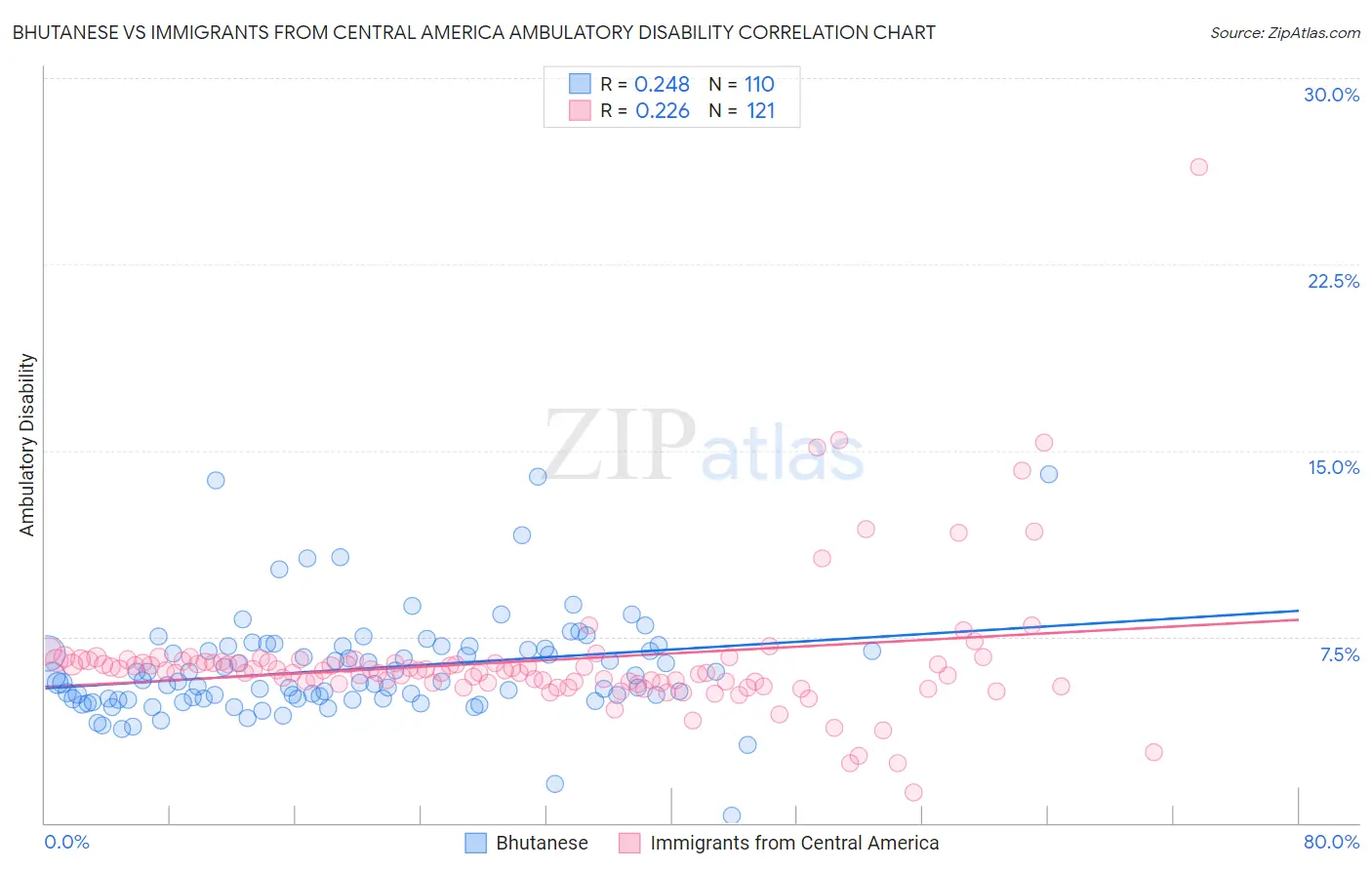Bhutanese vs Immigrants from Central America Ambulatory Disability
COMPARE
Bhutanese
Immigrants from Central America
Ambulatory Disability
Ambulatory Disability Comparison
Bhutanese
Immigrants from Central America
5.8%
AMBULATORY DISABILITY
98.8/ 100
METRIC RATING
89th/ 347
METRIC RANK
6.2%
AMBULATORY DISABILITY
20.1/ 100
METRIC RATING
201st/ 347
METRIC RANK
Bhutanese vs Immigrants from Central America Ambulatory Disability Correlation Chart
The statistical analysis conducted on geographies consisting of 455,305,094 people shows a weak positive correlation between the proportion of Bhutanese and percentage of population with ambulatory disability in the United States with a correlation coefficient (R) of 0.248 and weighted average of 5.8%. Similarly, the statistical analysis conducted on geographies consisting of 536,120,353 people shows a weak positive correlation between the proportion of Immigrants from Central America and percentage of population with ambulatory disability in the United States with a correlation coefficient (R) of 0.226 and weighted average of 6.2%, a difference of 8.2%.

Ambulatory Disability Correlation Summary
| Measurement | Bhutanese | Immigrants from Central America |
| Minimum | 0.28% | 1.2% |
| Maximum | 14.0% | 26.4% |
| Range | 13.8% | 25.2% |
| Mean | 6.2% | 6.5% |
| Median | 5.7% | 6.2% |
| Interquartile 25% (IQ1) | 5.0% | 5.7% |
| Interquartile 75% (IQ3) | 7.0% | 6.5% |
| Interquartile Range (IQR) | 2.0% | 0.85% |
| Standard Deviation (Sample) | 2.1% | 2.8% |
| Standard Deviation (Population) | 2.1% | 2.8% |
Similar Demographics by Ambulatory Disability
Demographics Similar to Bhutanese by Ambulatory Disability
In terms of ambulatory disability, the demographic groups most similar to Bhutanese are Australian (5.8%, a difference of 0.0%), Immigrants from Sudan (5.8%, a difference of 0.0%), Soviet Union (5.8%, a difference of 0.12%), Immigrants from Chile (5.8%, a difference of 0.16%), and Immigrants from Sierra Leone (5.8%, a difference of 0.17%).
| Demographics | Rating | Rank | Ambulatory Disability |
| Palestinians | 99.2 /100 | #82 | Exceptional 5.7% |
| Eastern Europeans | 99.2 /100 | #83 | Exceptional 5.7% |
| Ugandans | 99.2 /100 | #84 | Exceptional 5.7% |
| South Americans | 99.0 /100 | #85 | Exceptional 5.7% |
| Latvians | 99.0 /100 | #86 | Exceptional 5.7% |
| Immigrants | Chile | 98.9 /100 | #87 | Exceptional 5.8% |
| Soviet Union | 98.9 /100 | #88 | Exceptional 5.8% |
| Bhutanese | 98.8 /100 | #89 | Exceptional 5.8% |
| Australians | 98.8 /100 | #90 | Exceptional 5.8% |
| Immigrants | Sudan | 98.8 /100 | #91 | Exceptional 5.8% |
| Immigrants | Sierra Leone | 98.6 /100 | #92 | Exceptional 5.8% |
| Immigrants | Denmark | 98.6 /100 | #93 | Exceptional 5.8% |
| Kenyans | 98.4 /100 | #94 | Exceptional 5.8% |
| Immigrants | El Salvador | 98.4 /100 | #95 | Exceptional 5.8% |
| Salvadorans | 98.4 /100 | #96 | Exceptional 5.8% |
Demographics Similar to Immigrants from Central America by Ambulatory Disability
In terms of ambulatory disability, the demographic groups most similar to Immigrants from Central America are Albanian (6.2%, a difference of 0.030%), Immigrants from Cambodia (6.2%, a difference of 0.11%), Immigrants from Ukraine (6.2%, a difference of 0.14%), Immigrants from Congo (6.2%, a difference of 0.15%), and Slovene (6.2%, a difference of 0.17%).
| Demographics | Rating | Rank | Ambulatory Disability |
| Alaska Natives | 29.8 /100 | #194 | Fair 6.2% |
| Belgians | 28.6 /100 | #195 | Fair 6.2% |
| Malaysians | 28.2 /100 | #196 | Fair 6.2% |
| Poles | 26.3 /100 | #197 | Fair 6.2% |
| Immigrants | Bangladesh | 24.6 /100 | #198 | Fair 6.2% |
| Italians | 22.6 /100 | #199 | Fair 6.2% |
| Immigrants | Cambodia | 21.5 /100 | #200 | Fair 6.2% |
| Immigrants | Central America | 20.1 /100 | #201 | Fair 6.2% |
| Albanians | 19.7 /100 | #202 | Poor 6.2% |
| Immigrants | Ukraine | 18.4 /100 | #203 | Poor 6.2% |
| Immigrants | Congo | 18.2 /100 | #204 | Poor 6.2% |
| Slovenes | 18.0 /100 | #205 | Poor 6.2% |
| Finns | 17.2 /100 | #206 | Poor 6.2% |
| Alsatians | 15.1 /100 | #207 | Poor 6.3% |
| Bangladeshis | 14.2 /100 | #208 | Poor 6.3% |